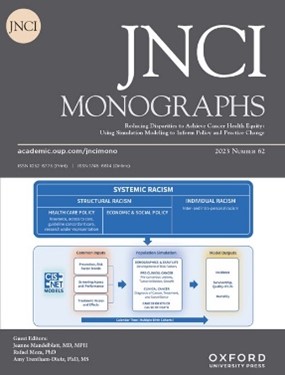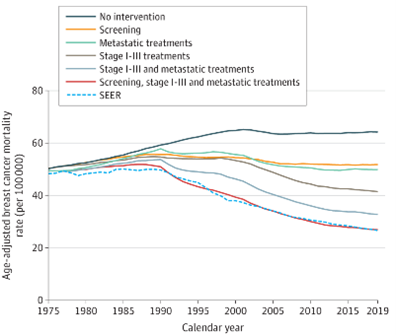CISNET – Cancer Intervention and Surveillance Monitoring Network
Highlights
 Analyses by CISNET researchers quantified the contributions of different points along the cancer control continuum on disparities in cancer mortality rates for female breast, cervical, lung, prostate, and colorectal cancers between the overall U.S. and Black populations.
Analyses by CISNET researchers quantified the contributions of different points along the cancer control continuum on disparities in cancer mortality rates for female breast, cervical, lung, prostate, and colorectal cancers between the overall U.S. and Black populations.
A recent CISNET analysis estimated the contribution that increased uptake of screening tests could make toward the Biden Administration’s reignited Cancer Moonshot goal.
 In this recent analysis published in JAMA, four CISNET models were used to estimate the contribution to the reduction in breast cancer mortality of changes in breast cancer screening and treatment since 1975.
In this recent analysis published in JAMA, four CISNET models were used to estimate the contribution to the reduction in breast cancer mortality of changes in breast cancer screening and treatment since 1975.
Cancer Sites
Models focus on the natural course of the disease and will address questions on its prevention, diagnosis, treatment, and surveillance.
Models focus on critical early detection and clinical management issues, and are being used to evaluate mortality outcomes, harms and costs of rapidly evolving cancer control paradigms.
Models focus on the natural history of human papillomavirus (HPV) and cervical carcinogenesis, the impact of HPV vaccination and screening, the comparative effectiveness of HPV vaccination and screening strategies, and approaches to reduce cervical cancer disparities.
Models focus on the natural history of the disease and the impact of interventions, including targeted screening, on mortality.
Models are being used to produce innovative changes to gastric cancer care through a disparities oriented modeling approach focused on the most vulnerable, high-risk populations that bear the greatest gastric cancer burden.
Models focus on tobacco control policies and interventions in the US and other countries, lung cancer screening and early detection, targeted therapies and immunotherapies, and investigation of the synergistic impacts of those strategies.
Models focus on the natural history of the disease and the impact of novel strategies in preventing and treating multiple myeloma, with the goals of reducing its burden and mitigating disparities.
Models focus on investigating risk-based screening and treatment strategies and approaches for reducing racial disparities.
Models are being used to inform strategies for reducing uterine cancer incidence and mortality by improving prevention, screening, and treatment.
